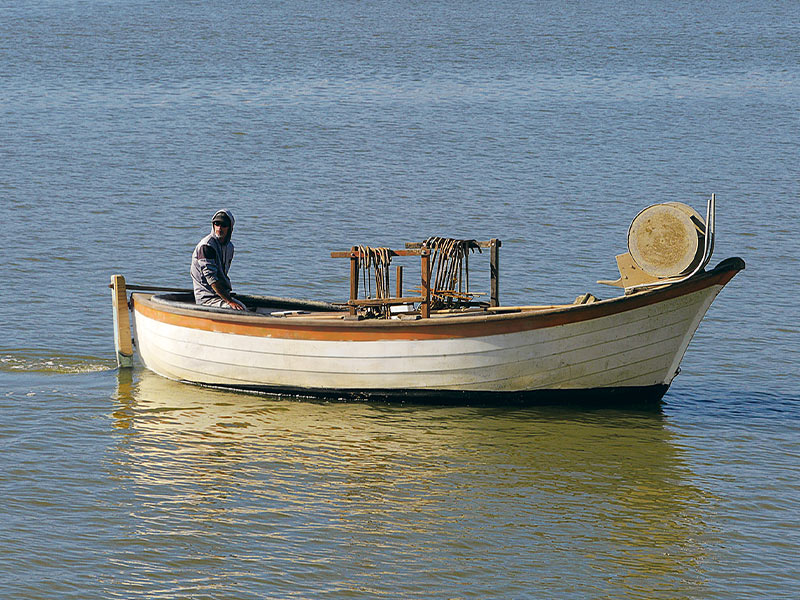NZ’s first electric commercial fishing boat?
5 min read
The 40-year-old dory hides a technological upgrade. Photo: Randolph Covich
Northland’s Hokianga Harbour probably isn’t the first place you’d think of as a location for what may be the country’s first electric-powered commercial fishing boat, but it’s here that fisherman Craig Pinkney has stepped forward and embraced a technology that has yet to gain mainstream acceptance in the marine industry.
Granted we’re not talking about a large vessel here, but often it’s operators like Craig who understand the benefits certain systems can offer users, especially when working from remote locations.
Based in Kohukohu, some 70km south of Kaitaia, the Pinkney family has been fishing the Hokianga Harbour for more than 50 years. With a catch primarily based around flounder and dogfish, the business now resides in the hands of Craig, the second generation to commercially fish the upper reaches of the harbour.
For any owner of plant and equipment in the area, the accessibility to fuel supplies can be an issue, with Craig’s nearest supplies being more than 20km away by road or from Rawene on the other side of the harbour.
“We usually fill the boat using 20-litre cans of diesel, so there was always a need to travel and collect fuel,” says Craig.
“Another thing is that it doesn’t matter how careful you are, small spillages do occur occasionally, which means carefully cleaning everything up. Handling fuel is messy and a nuisance.”
Couple those issues with Craig’s ethos on environmental stewardship and it quickly becomes evident that he believes actions speak louder than words. Case-in-point is the recent electrification of his main fishing boat.
Measuring six metres in length, the 40-year-old dory boat was built by Craig’s father Malcolm, who is well-known in the region for his craftsman skills. The first versions were constructed of wood, eventually transitioning to a fibreglass mould, from which a number were made and one that Craig uses today.
An Italian-made Lombardini diesel was the most recent engine fitted, preceded by Volvo, Lister, and Deutz brands.
“Engines get replaced roughly at 10-year intervals. We started out with water-cooled but moved to air-cooled engines, which went well but are noisy to work around,” says Craig.
Another issue with fossil-fuelled engines besides the noise is their exhaust fumes – another good reason to change power systems, especially when working for extended time periods in the close confines of
a relatively small boat.


With the advent of more efficient electric systems for marine craft, a strong case began emerging for powering the boat with battery power.
“My dad was the one to suggest we look at repowering with an electric engine,” says Craig. “He had been studying them for a while and thought, if they can electrify ferries and charter boats, something similar could be achieved with a small fishing boat.
“So, we spoke to Chris Claydon, who specialises in electric marine propulsion systems and runs small electric charter crafts in Kerikeri,” says Craig.
After evaluation, Craig selected a system that consisted of a five-kilowatt motor that runs the propeller shaft via a belt drive. There was consideration for a direct drive set-up, but it would have meant situating the motor lower in the hull and at more risk of salt water.
“Chris had a couple of batteries that came off America’s Cup yachts, so we got them second-hand. That gives us seven kilowatts of battery power and at full revs gives about one-and-a-half to two hours, but we run it on about a third revs, so reckon we have about five to six hours of steaming time,” says Craig.
Once a meter is fitted, Craig will have a more accurate idea of power usage.
“We’re doing a hull speed of around four and a half to five knots. We might have a play around with a different prop at some stage but currently are using the same prop as before.”
Power-wise the boat operates differently from the prior diesel system, as it is producing more torque than before.
“It is a five-kilowatt electric motor, which is eight and a half horsepower. Before we had a 20hp engine, which I think had about eight Newton metres of torque. The electric motor has more than 100 Newton-metres,” says Craig.
“At the moment we’re getting hull speed from about 40 to 45% revs, and it’s got a lot more, but once we get too high, it’s starting to slip on the belt,” says Matt Lyons, who helped Craig fit and commission the electric system.
“So, while we can accelerate faster, you get the issue of pressure from the prop in the water, which can cause belt slippage, so we’re looking at changing things up a bit there,” says Matt.
“We don’t need more power than hull speed, otherwise, we’re just burning batteries,” says Craig.
At night, the boat plugs into single-phase power, and it is ready for use the next morning.

Craig says the move to electrification hasn’t changed the way the business as a whole operates, but the combination of a number of things makes a working day easier than before.
Not having to carry fuel down each day and no exhaust fumes to contend with, along with the significant noise reduction compared to an air-cooled diesel engine are benefits of electrification.
“So far, it’s pretty good to just go down, flick a switch and away we go. Eventually, I’d like to put some solar panels on the boat, which would also act as a shelter. I’m told that it should keep the batteries fully charged, so we might see how that goes,” says Craig.
With the Northland region being 95% supplied by the geothermal power plant in Ngawaha, once Craig electrifies the petrol-powered net hauler, there is a strong case that he will then be supplying a
carbon-neutral catch, that is one not being offset with the purchase of carbon credits, but that is a whole other story.



